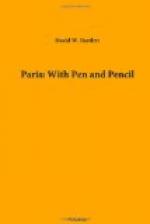It was a long, low interior, and one end of the room
was fenced off from the rest, and in it a row of dead
bodies was arranged against the wall. Jets of
water were playing constantly upon them, and upon
hooks the garments of the deceased were hung.
The use of
La Morgue is to exhibit, for twenty-four
hours, the dead bodies which are found in the streets
and the river. If no friend in this time recognizes
and claims the body, it is buried. There were
five bodies when I was there—four men and
one woman. The men were evidently suicides and
the woman was probably murdered, as there were marks
of violence upon her body, which could not have been
self-inflicted. There are several hundred persons
exhibited in La Morgue in the course of a year, and
they tell strange stories of the misery and crime
which abound in the finest city in the world.
The majority of the bodies which are found, are suicides,
but many are those of persons who have been murdered.
The French commit suicide for reasons which appear
frivolous to the American or Englishman. The
loss of a favorite mistress, an unsuccessful love-intrigue,
the bursting of a bubble of speculation, and sometimes
a mere trifle is enough to induce self-destruction.
Sometimes a man and his mistress, or a whole family
shut themselves up in a room with burning charcoal,
which is a favorite method of committing suicide.
A great many bodies are fished out of the Seine, for
it is very easy for a poor and wretched man or woman
to leap into it in the darkness of night. The
next day the body lies for recognition in La Morgue,
and if no good friend claims it it is borne by careless
hands to a pauper burial.
[Illustration: LE PONT-NEUF]
I crossed the Seine by the Pont Neuf—a
fine bridge, completed in 1604 by Henry IV. Near
the center of it, standing upon a platform and pedestal
of white marble, is a splendid bronze statue of Henry
IV. upon horseback. The height of the statue
is fourteen feet, and its cost, somewhat above sixty
thousand dollars, was defrayed by public subscription
in 1818.
The Place Vendome, too, lay in my path, so called
from having been the site of a hotel belonging to
the Duke de Vendome, illegitimate son of Henry IV.
and Gabrielle d’Estrees. The Place is now
ornamented by a magnificent pillar, erected by Napoleon
in honor of his German campaign.
I passed also the beautiful Fountain des Innocents,
whose sculptor, the celebrated Jean Goujon was shot
during the massacre of St. Bartholomew, while working
at one of the figures.
[Illustration: Fontaine des Innocents.]
* * * *
*
NAPOLEON AND EUGENIA.
On my second visit to Paris, I found that many changes
had taken place, and some of them striking ones.
It was especially true of the architectural condition
of Paris. In the years which elapsed between my
visits, the Louvre had assumed a new appearance, and
was now connected with the Tuilleries Palace.
Other changes of a similar character had occurred.




